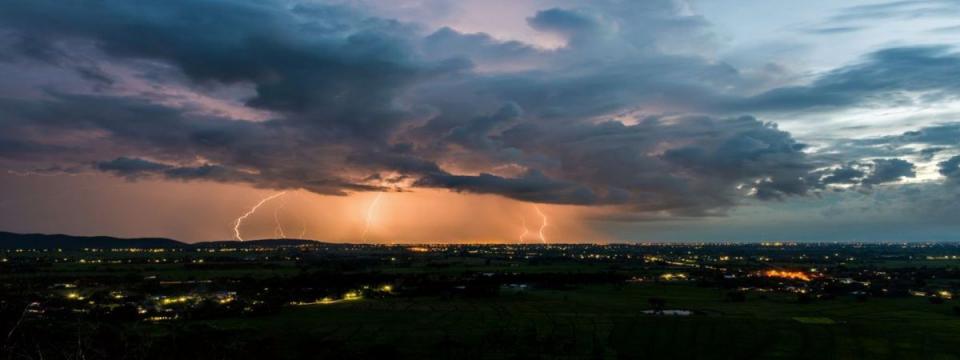Severe Thunderstorm or Tornado
Thunderstorms can occur at any time of the year in this county; they are most frequent in the spring and least frequent in the winter. Any thunderstorm may have gusty winds and a chance of a dangerous lighting strike. These dangerous storms often have frequent lightning, damaging wind-sand heavy rain. A tornado is a possibility whenever a severe thunderstorm occurs. Tornadoes may strike with little or no warning, leaving a path of almost total destruction from 100 yards to one mile wide and from 5 to 50 or more miles long. A tornado may move along its damage path at a speed of 30 to 75 miles per hour.
- A SEVERE THUNDERSTORM WATCH or a TORNADO WATCH means that atmospheric conditions are favorable for the formation of one or more severe thunderstorms or tornadoes.
- A SEVERE THUNDERSTORM WARNING or a TORNADO WARNING means that a severe thunderstorm or a tornado has actually been sighted or indicated by weather radar.
When a thunderstorm occurs, don’t panic. Although lightning kills more people each year than any other weather hazard, your chances of being hit by lightning are approximately one in a million.
To minimize your chance of being struck by lightning:
- If you’re outside, get into a building or vehicle.
- If in a forest, pick a low area under thick small trees.
- If swimming or boating, get out of the water immediately. In open water, you are the highest object, and the most likely target for lightning.
- If in an open area, head for low ground or crouch down, but avoid narrow valley or ravines, which may be channels for flash floods. If you feel your hair stand on end, drop to your knees where you are and bend forward immediately, putting your hands on your knees. Don’t lie flat on the ground; this will maximize your contact with the current-flow area.
- Avoid tall trees, poles, hills, overhead wires, clotheslines, metal pipes and other objects and water. The worst place to be in a thunderstorm is under a tall tree on a hilltop.
- Do not use the telephone except in an emergency.
When a SEVERE THUNDERSTORM WATCH is issued: Advise all personnel of the weather condition.
- Monitor radio/television or National Weather Service (162.550 MHz) for updates.
- Save work on computers frequently; sudden power disruptions may cause you to lose important data and information.
- Modify outdoor activities to ensure that relatively quick access to shelter is available.
- If swimming or boating, prepare to leave the water quickly.
- Monitor sky conditions. If you see a revolving funnel-shaped cloud, seek shelter immediately. If possible, CALL EMERGENCY 9-1-1 IMMEDIATELY AND REPORT IT.
- Terminate routine outdoor activities; seek shelter.
- Tie down or otherwise secure outdoor objects that could blow away and cause damage or injury
When a TORNADO WATCH is issued, in addition to the actions to be taken under a SEVERE THUNDERSTORM WATCH:
- Cease swimming and boating activities; if a tornado occurs, there may not be enough time to get out of the water and into a safe shelter.
- Cease any other outdoor activities that would unduly delay the seeking of shelter.
- Monitor sky conditions. If you see a revolving funnel-shaped cloud, seek shelter immediately. If possible, CALL EMERGENCY 9-1-1 IMMEDIATELY AND REPORT IT.
When a TORNADO WARNING is issued, or if you sight a tornado without warning:
- Monitor radio, television, or the National Weather Service continuously.
- Monitor sky conditions continuously. If you see a revolving funnel-shaped cloud, seek shelter immediately. If possible, CALL EMERGENCY 9-1-1 IMMEDIATELY AND REPORT IT.
- Turn off all utilities to minimize the possibility of fire.
- Move all personnel to best available tornado shelters: basement or cellar, cave, or underground excavation; center of basement or lowest level of well-constructed building; interior hallway, closet, or bathroom – away from windows, doors and outside walls; and under sturdy furniture or stairs.
- If in automobile, mobile home or building with wide-span roof: get out and seek other shelter immediately; if outside, move at right angles to the tornado’s path; and if you can’t escape, lie flat on the ground, preferably in a low spot that is not flooded or subject to flash flooding and protect your head from flying debris.
After the tornado or damaging severe thunderstorm:
- Check for injuries; provide first aid.
- Check facility for damages.
- Turn on and check utilities.
- Report any utility outages.
- Stay away from disaster areas, except to assist in rescue and recovery efforts.
Remember that tornadoes may pass in just a few minutes and that they are extremely destructive during that time.
Links:
- DWR Division of Flood Management - https://water.ca.gov/Programs/Flood-Management
- Flood Emergency Management System - http://fems.water.ca.gov
- Flood Center - flood_center@water.ca.gov
- National Weather Service San Diego (NWS) - http: www.weather.gov/sandiego
- National Weather Service Las Vegas (NWS)- http://www.weather.gov/lasvegas
- National Weather Service Phoenix 9 (NWS) - http://www.wrh.noaa.gov/psr/
- San Bernardino County Flood Control District - http://www.sbcounty.gov/trnsprtn/pwg/alert
- Governor’s Office of Emergency Services - http://www.caloes.ca.gov/home
- Federal Emergency Management Agency - https://www.ready.gov/tornadoes

